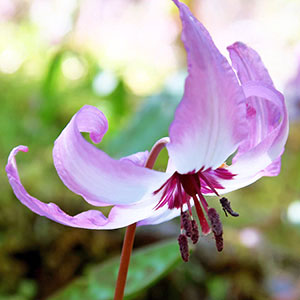Erythronium hendersonii
Erythronium propullans
Henderson's fawn-lily
Minnesota dwarf trout-lily, Minnesota fawnlily, Minnesota trout lily
slender, 40–55 mm.
ovoid, 10–25 mm;
stolon 1 in flowering plants, arising from halfway up stem, 1–3 from bulbs of 1-leaved, nonflowering plants.
10–25 cm;
blade mottled with irregular streaks of brown or white, oblong to ovate, margins entire to ± wavy.
4–13 cm;
blade green, irregularly mottled, elliptic-lanceolate to ovate-lanceolate or elliptic, ± flat, glaucous, margins entire.
reddish, 12–30 cm.
3.9–12 cm.
1–4-flowered.
1-flowered.
tepals violet to pink, darker at tips, dark purple at base, broadly lanceolate, 18–35 mm, inner with small auricles at base;
stamens 10–14 mm;
filaments violet-purple, linear, slender, less than 0.8 mm wide;
anthers pale brown to purple;
style violet, 6–8 mm;
stigma unlobed or with lobes shorter than 1 mm.
tepals 4–6, strongly reflexed at anthesis, pale pink to white, darker abaxially, lanceolate, 8–15 mm, auricles absent;
stamens 2–6, 6–8 mm;
filaments white, lanceolate;
anthers yellow;
pollen yellow;
style white, 6–10 mm;
stigma ± unlobed.
obovoid, 2–4 cm.
very rarely produced; when present, may be result of hybridization with Erythronium albidum.
= 24.
Erythronium hendersonii
Erythronium propullans
Of conservation concern.
Erythronium propullans is known only from Goodhue and Rice counties. It often forms extensive colonies in which flowering plants are sometimes more abundant than nonflowering, 1-leaved ones, and sometimes the reverse. It grows mixed with E. albidum (J. A. Banks 1980), and putative hybrids between them have been reported (T. Morley 1988). Flowers frequently have fewer than six tepals and stamens (C. O. Rosendahl 1919), and may occasionally have only two carpels.
(Discussion copyrighted by Flora of North America; reprinted with permission.)


